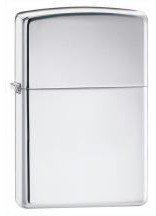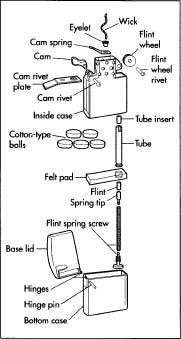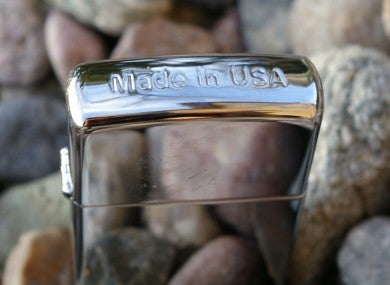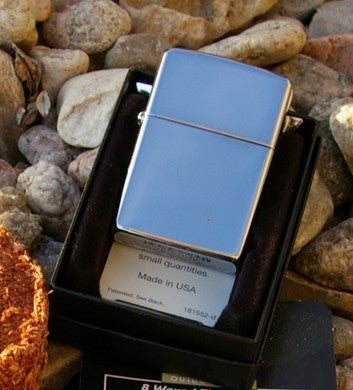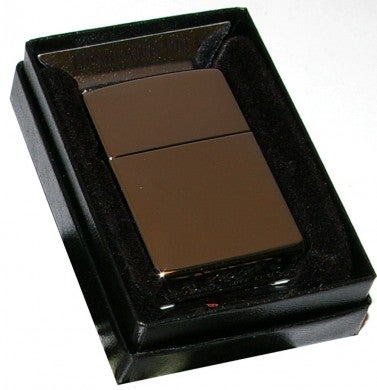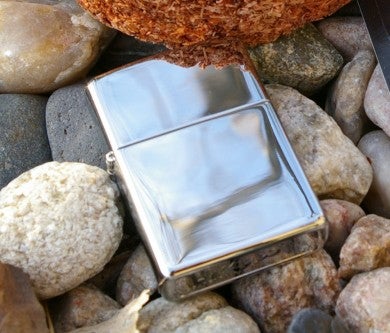Zippo survival lighter
Major Pandemic 09.05.13
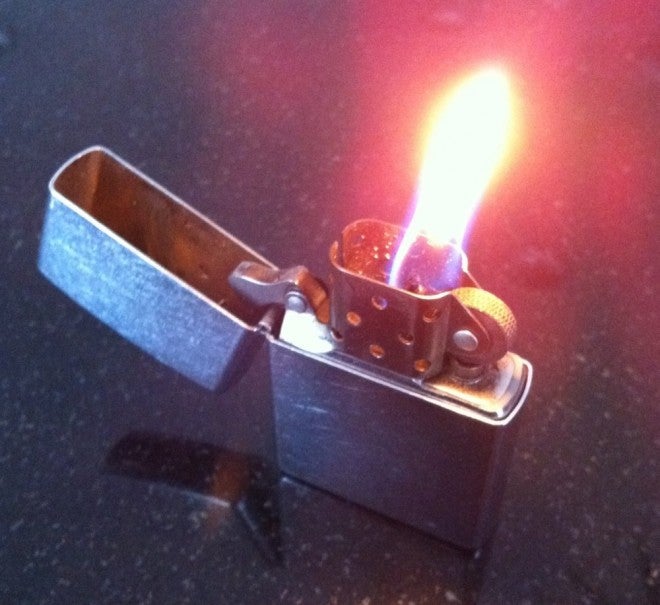
The “Zippo Survival Lighter” is not a new product from Zippo. Rather, it’s my way of labelling the ordinary, ubiquitous Zippo, which is without a doubt the best long-term survival lighter in world. Here’s why I believe that the Zippo is your ultimate, made-in-the-USA firemaking friend if TSHTF.
Unless you just arrived here from Mars, you have undoubtedly handled a Zippo lighter at some point in your life. Zippos were invented in 1933, and the design has been continuously tested and refined over almost 80 years. The lighter’s operation is infallibly simple, and the design is elegantly bulletproof. To say they are durable is an understatement. Actually Zippo just posted a picture on their Facebook site of a Zippo which stopped a .38 Special bullet and saved a man’s life. The major flint, wick, and the cotton batting components are all easily replicable. With a near unlimited selection of case motifs, you will certainly find one that fits your personality, and Zippo even has a few various case size styles as well. As the saying goes, if it isn’t broke don’t fix it.
The movie Book of Eli, set in the post apocalyptic future gave me a lot of opportunity to think about what survival would be like 20+ years after “it hit the fan”. Little details caught my eye, such as the fact that the Zippo lighter had became a valuable trade item. If the S really did make contact with the F, I imagine Zippos would be highly valued for a number of reasons, which I’ll enumerate below.
Features
The 100% USA made Zippo will really be the only lighter that will work after all the pressurized or disposable butane lighters are broken or empty, assuming you have enough flint. But flints from disposable lighters can be harvested, and wicks and cotton packing material can be made.
The Zippo is also the only lighter which can run on almost any flammable fuel that ignites when a spark is applied to it. Even if you don’t have fuel or a wick, the cotton stuffing can be removed and used as tinder with the striker to still make fire.
Another benefit of the Zippo is that the wick can be adjusted to different heights for a little or a lot of fire depending on the need or the fuel used. Thumb free, it can provides a small, sustainable, no-hands fire where other methods would be impractical or inconvenient. And when placed on a fireproof surface it can burn from full to empty, a feat that no other commercial lighter can do without exploding or melting into puddle of plastic. This hands-free, self-standing feature means that you can heat a cup of water with a Zippo, which I have done, or use it as a simple heat source for everything from melting paracord to taking a little chill out of your one man tent.
I have several Zippo lighters, but my newest acquisition is the mirror polished version, which now provides me with all the benefits of the Zippo plus a very effective personal and signal mirror, thereby combining two common survival devices into one handy package.
Surviving with a Zippo
The Zippo lighter has some the aforementioned benefits as a survival tool, such as a near indestructible case, function unaffected by altitude, easy maintenance and repair, no-hands burning, signaling/mirror if you have a polished model, and simple mode of operation. But you’ll still need refills for parts of it. This being the case, you should know what preferred Zippo supplies to have on hand to support your Zippo long-term.
In an article on the Survival & Self Reliance website, the author compiled 448 days of Zippo use data by lighting approximately 3 cigarettes a day, which provided interesting information such as: flints lasted an average of 44 day, refills lasted on average 12 days, and wicks average life span was 111 days. Based on the compiled data from the SSRSI.ORG site a Zippo user would need 12oz of Zippo lighter fluid, two packages of flints, and two wicks per year to run in factory spec state if you are a chain smoker. It is common practice to stash a couple wicks and extra flints under the felt, and a 6-month supply of one wick and six flints can easily fit under the felt and batting for the time you need it. All handy information to know.
Where almost every other lighter requires special fuel, in a survival situation the Zippo can operate on almost any fuel which will ignite when exposed to a flame. Although not recommended by Zippo, the SSRSI.org author also went on to test various alternative Zippo lighter fuels, and listed the quoted text below as tested alternative fuels to be used in a survival situation.
“All wick lighter fuels (Zippo, Ronsonol, etc.) – BEST
Camp Fuel (naphtha) – NEXT BEST
Some Paint Thinners (naphtha) – ALSO GOOD
Rubbing Alcohol (isopropyl alcohol) – GOOD ALTERNATIVE
Everclear / Grain Alcohol (ethyl alcohol aka “moonshine”) – GOOD ALTERNATIVE
Kerosene – WORKS
Cologne – WORKS
Diesel Fuel – WORKS
Jet Propellant (JP – 4) – WORKS
Lamp Oil – WORKS, BUT HARMFUL TO LIGHTER’S FUNCTION
Gasoline (dangerous but does work) – POTENTIALLY EXPLOSIVE”
One of the most significant notes of his testing was validation that Camp Fuel, which many of us have already tested in Zippos, works as well as wick lighter fluids. I have noticed camp fuel typically does have a smellier burn than some of the more refined wick lighter fuels. From a disaster preparedness perspective you should have a low-tech, manual, pressurized camp stove and at least a gallon of camp fuel on hand anyway. So it’s good to know that one gallon of fuel could also be used as a nearly infinite supply of Zippo lighter refills, as well.
The flints on the Zippo are very good compared to most other disposable lighter flints. When using them to start tinder when the fluid is dry, simply move the wick over to the inside and loosely place your tender in the wick cage. If you have a nice dry and light tinder (perhaps some of that cotton battening from the lighter itself), it will start right up.
Once the tender is lit, move it to your pre-prepared tender bird’s nest to facilitate a bit more fire. One tip is that the standard, cotton-like fluid filler is actually synthetic and does not burn well, so I do recommend replacing all or some of it with real cotton, which will provide you with extra tinder. For longer term storage your Zippo can be filled and then dipped in wax to seal it from evaporating, however the wax should be removed prior to use. Another option is to use an empty contact fluid bottle to carry your spare fluid for extended storage.
Final thoughts
I always carry a couple disposable butane lighters in all my Bug Out Bags, along with ferrocerium rods. High-end, windproof micro-torches are without a doubt the fastest firemaking tools available, but they go through fuel quickly… and then what. In a very long-term survival situation, the Zippo becomes a preferable fire making tool because of the availability of refill fuel.
Ferro rods are an indiipensible back up option, but a lighter will always be a quicker and simpler fire making option. If a catastrophic event occurs, the Zippo becomes a barter-able item. Until then, you can slip a one of the most well recognized and coolest fire making tools in your pocket for about $20, for the just-in-case we hope will never happen out in the streets or out in the woods.
